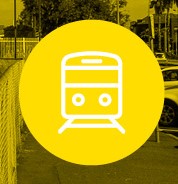Bayside City Council has prepared an Integrated Transport Strategy (ITS) 2018 – 2028 to establish a strategic direction to guide transport planning decision making within Council over the next 10 years. It identifies a range of actions that Council can implement to make Bayside a better place and overcome some of the challenges facing the City of Bayside.
At the June 2018 Council Meeting, Council resolved to :
1. Adopt the Integrated Transport Strategy 2018 – 2028;
2. Receive a report on the annual progress of the implementation of the Integrated Transport Strategy 2018 – 2028 at the conclusion of each financial year;
3. Noted that the Bayside Public Transport Advocacy (2016) will not be reviewed or updated as advocacy actions are included in the Integrated Transport Strategy 2018; and
4. Thanked all stakeholders and community members for their valuable input and feedback which has informed the finalisation of this document.
The adopted Strategy is available here
Feedback
Council wants your feedback on the draft Integrated Transport Strategy
CLOSED: This survey has concluded.
Ideas
Parking
Speed Limits
Quick Poll
Would you support reduced speed limits in some local Bayside streets to help make roads safer for pedestrians, cyclists and other road users?
This poll has concluded.
- Yes 72% (23 votes)
- No 25% (8 votes)
- Unsure 3% (1 vote)
More Info
About the Integrated Transport Strategy

Feedback you provide will filter into the development of an Integrated Transport Strategy.
The Strategy will strengthen the relationship between community aspirations and Council's transport planning. It will have an emphasis on planning for a more sustainable transport future where we will grow mobility within the community whilst managing traffic and parking congestion as best we can.
Themes of the Strategy:
The Integrated Transport Strategy will focus on the following areas:
- Walking and Cycling: Walking and cycling will be prioritised as the preferred modes of transport for short trips in Bayside
- Better Public Transport: Council will advocate to the State government for improved public transport access to, within and from Bayside
- Parking and Access: Council will balance the needs of all drivers to ensure a reasonable likelihood of parking close to their destination
- Safer Streets: Bayside’s streets will be actively managed to provide the safest and most efficient transport system possible for all road users
- Integrated Transport and Land Use: Council will work to ensure that land use development supports sustainable transport use
- Enable Choice and Educate: Council will seek to increase awareness within the community about the benefits of sustainable travel and emerging transport technologies that contribute to a reduction in transport related emissions
Why have an Integrated Transport Strategy?

A steady increase in population and affluence has led to an annual growth in private motor vehicle registrations in Bayside of 1.9%. This means that there will be an additional 20,000 private vehicles competing for road and parking space in Bayside over the next 10 years. Providing additional capacity through more road and parking space is not a sustainable solution to this dilemma.
To manage this growth we need to shift our reliance from private vehicles to alternative modes of transport.
The updated Integrated Transport Strategy will strengthen the relationship between community aspirations relating to transport and Council’s direction for transport planning and provision.
Have your say on transport in Bayside:
How will Council encourage walking and cycling?

The Integrated Transport Strategy will aim to prioritise and promote walking and cycling as the preferred modes of transport for short trips in Bayside.
Private vehicles are likely to continue to play a prominent role in Bayside’s transport environment well into the future. However, Council also has a responsibility to raise awareness of all transport choices and support suitable initiatives aimed at reducing transport related emissions.
Walking and cycling are the most sustainable and efficient forms of transport and have a significant part to play in the transport system. They are an effective way to improve fitness and reduce risk of common health problems such as diabetes and cardiovascular disease. Providing safe and efficient walking and cycling networks within the municipality is integral to achieving a sustainable transport system that enhances quality of life for all residents.The challenges and complexities of this approach are listed below.
Challenges
- There are some streets within the municipality that do not have footpaths
- There is a lack of pedestrian facilities (e.g. safe crossing opportunities and seating etc) along key walking routes
- The ability to provide on-road bicycle lanes that meet current design standards along some roads within the municipality is limited due to the presence of on-street parking provision e.g. Highett Road
- There is a perception that cycling is unsafe
- Some sections of the Bay Trail shared path do not meet current design standards due to the volume of pedestrians and cyclists using the shared path
- Reported issues of pedestrian and cyclists conflict on the Bay Trail shared path
Potential Solutions
- Expand Council’s Footpath Connectivity Program to construct new footpaths in those streets without footpaths
- Establish a program of works to provide more pedestrian crossings at key locations across the municipality
- Reduce the speed limit on some roads within Bayside to improve the pedestrian and cycling environment
- Address each of the high risk safety hazards on the Bay Trail shared path
- Develop education campaigns aimed at improving respect between shared path users
Benefits
Walking and cycling to local destinations can:
- Help to increase physical activity levels;
- Reduce traffic volumes and the demand for parking within our road space;
- Remove the stress of trying to find a suitable parking space
- Increase pedestrian and cyclist activity within our shopping centres
- Lowers local carbon emissions; and
- Foster more social opportunities







